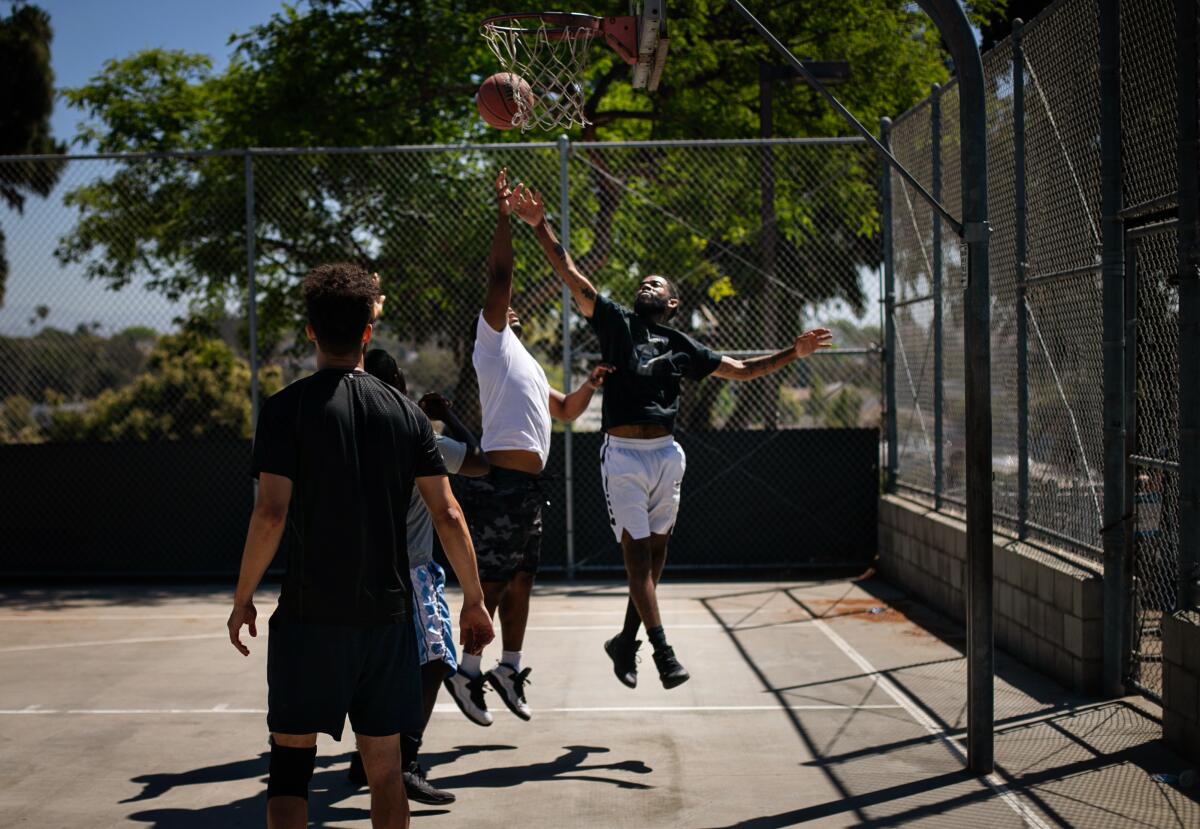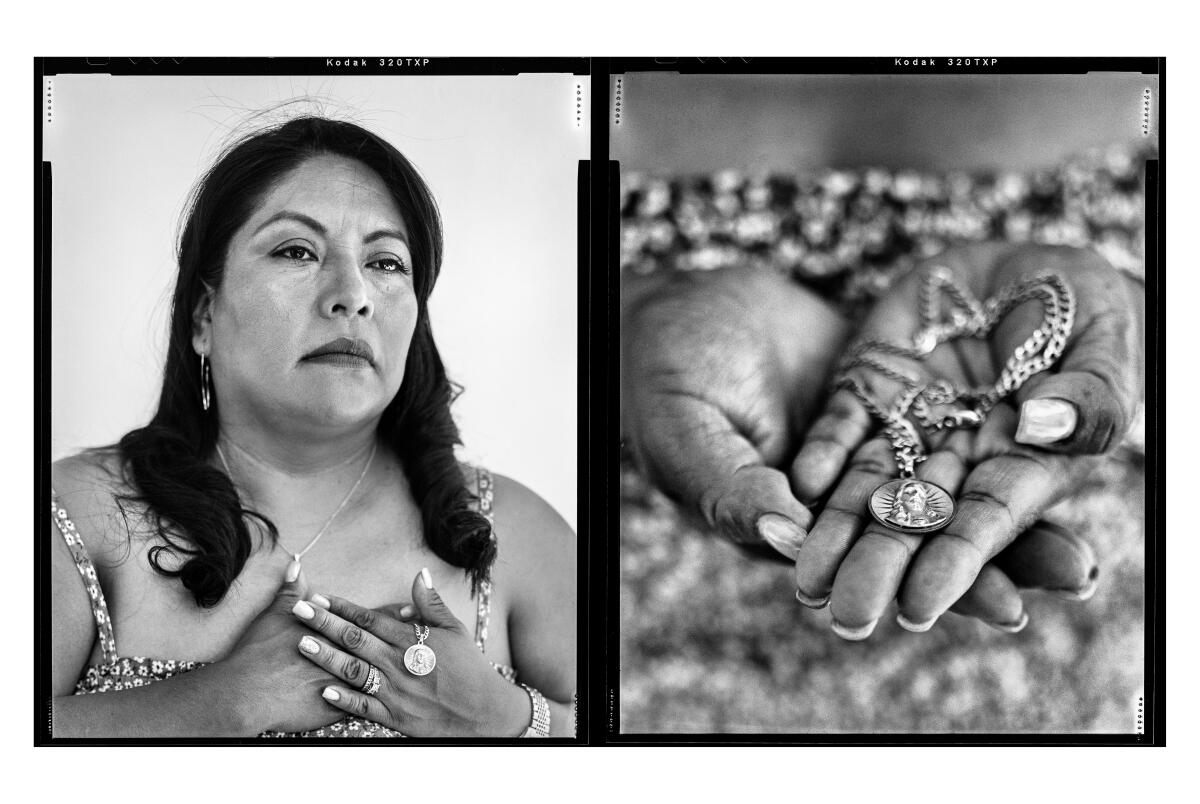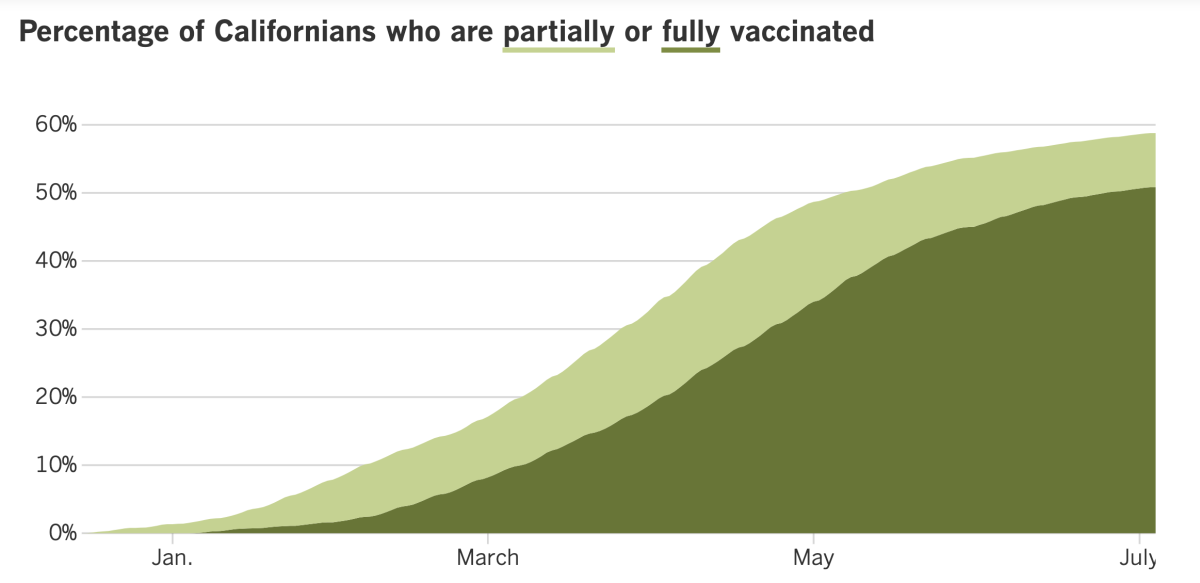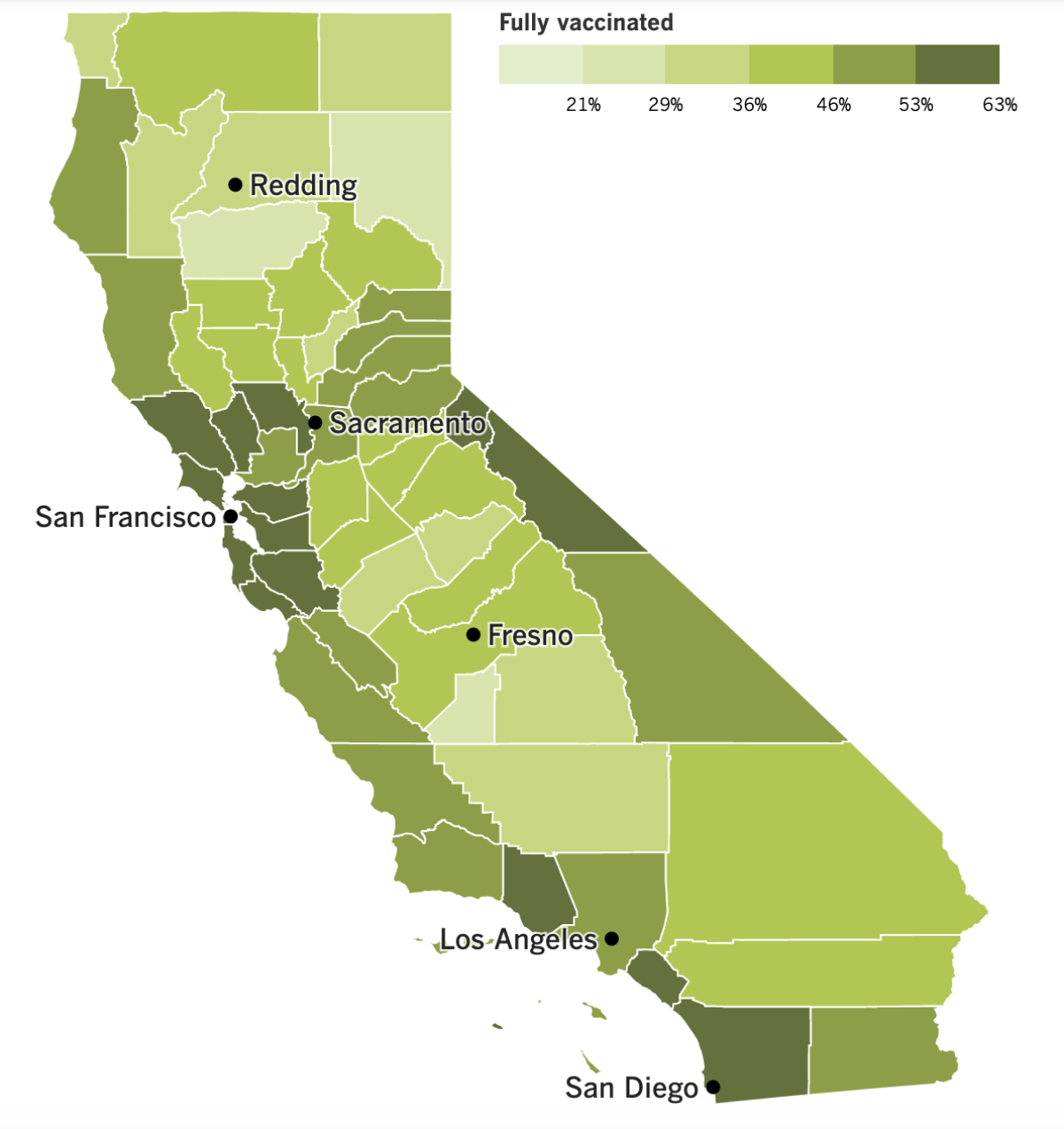Coronavirus Today: Hoops or hospitals?
Good evening. Iâm Karen Kaplan, and itâs Tuesday, July 6. Hereâs whatâs happening with the coronavirus in California and beyond.
Itâs been three weeks since California reopened its economy. With each passing day, our lives inch closer to their pre-pandemic normal. The latest sign comes from Santa Monica, where pickup basketball games are back in Joslyn Park.
Sure, the players may be a little out of practice. Theyâre relying on knee and ankle braces to protect their joints while they become reacquainted with the proper footwork. Their jump shots arenât automatic like they used to be.
But itâs not their level of basketball skill thatâs important. Itâs that theyâre finally together on the court after a 15-month timeout.
âItâs our golf course,â Kirkland Lynch, an attorney whoâs played at Joslyn Park for years, told my colleague Donovan X. Ramsey. âWe get out there and talk shop â everything from investments to politics to sports, or just joking around. Those are our Saturday sessions where we debate and talk and, you know, congregate.â

Santa Monica closed its public basketball courts on March 12, 2020. When people showed up to play anyway, workers took the rims off the backboards.
âIt felt so weird,â said Micah Akerson, the cityâs principal community services supervisor. âItâs not something we like to do. We like to fill the facilities, but in this case, we had to do the opposite to keep everybody safe.â
Some of the regulars tried to move their game to courts in East L.A. or Highland Park. It wasnât the same. In deference to pandemic safety, they mostly stuck to one-on-one games, or shot baskets on their own.
When COVID-19 vaccines were available, they became a hot topic on the playersâ group chat. They discussed the safest way to resume their weekly game without putting anyoneâs health at risk.
âIt all came back together so quickly,â said Jermaine McMihelk, an asset manager from Compton who started playing at Joslyn Park about five years ago. âIt went from this huge void to, once the vaccine rolled out and everybody was comfortable, we picked up like we never left.â
The key word there is âvaccine.â On the same day Ramseyâs story was published, my colleagues Rong-Gong Lin II and Luke Money reminded us that itâs still too soon to let our guard down.
Coronavirus cases have been falling for white, Latino and Asian Americans in Los Angeles County, but theyâve climbed among Black residents â the group least likely to be vaccinated, according to data from the L.A. County Department of Public Health.
Only 44% of Black Angelenos ages 16 and up have received at least one dose of a COVID-19 vaccine. That compares with 54% of Latino, 61% of Native American, 65% of white and 75% of Asian American residents in that age group.
Health experts say itâs probably not a coincidence that the two-week coronavirus case rate for Black residents rose 18% between mid-May and mid-June while it declined 4% for Latino, 6% for white and 25% for Asian American residents. Whatâs more, the hospitalization rate rose 11% for Black residents while falling 29% for Latino, 37% for white and 12% for Asian American residents.
âWhat weâre seeing in L.A. is what weâll see in other urban centers: The cases and the hospitalizations will rise among those who are unvaccinated,â said Dr. Kirsten Bibbins-Domingo, epidemiologist at UC San Francisco. âThis can move actually very quickly to devastate the Black communities.â
It doesnât have to. Just ask the hoops players at Joslyn Park.
By the numbers
California cases, deaths and vaccinations as of 6:10 p.m. Tuesday:

Track Californiaâs coronavirus spread and vaccination efforts â including the latest numbers and how they break down â with our graphics.
A more meaningful Independence Day
The Fourth of July isnât usually a time for reflection â not like Memorial Day or Thanksgiving. But weâve all come a very long way in the last year, so L.A. Times columnist Gustavo Arellano asked Southern Californians what this holiday meant to them. Their responses may give you a new perspective on freedom and independence.
When Dr. Jerry Abraham was a kid, Independence Day barely registered as a holiday. He felt fortunate if he got to celebrate with a hot dog, some ice cream, and a glimpse of fireworks. But since both his parents usually worked on the Fourth, there were plenty of years when he didnât celebrate.
If he were still that kid, heâd have had plenty of company this weekend.
âI struggle knowing 600,000-plus Americans will not celebrate this July Fourth,â said Abraham, who now runs the COVID-19 vaccination program at Kedren Community Health Center in South L.A., in an interview before the holiday. âThey are gone from this world because of the terrible pandemic that wreaked havoc.â
One of them is Dario Urbina, who was in the hospital last July 4 and died two days later.
His wife, Griselda Urbina, ignored that Independence Day, even though itâs usually one of her favorite holidays. âI didnât have the spirit to celebrate,â she said.
This year, she and her four children â all of whom battled COVID-19 â visited Darioâs grave on the Fourth of July. After months of mourning, they held a small party to honor his life.
Griselda said her mindset changed in February.
âWeâve suffered a lot. We lost my husband,â she said. âWhat more can we lose? And I stopped feeling fear.â

Max Thayer was hospitalized with COVID-19 as well. He was luckier than Dario Urbina, and was able to go home after a two-month stay.
Now the 75-year-old Army veteran sees independence differently.
âNo one is truly independent in the sense of our friends, our family, our lives [being] intertwined with other human beings,â said the Vietnam-era Army veteran. âI think that we all depend on each other.â
The pandemic cost Jamie Eagen her job as a law office manager. It was the first time in her life sheâd been laid off.
The single mom is still looking for a new job, but that didnât stop her from pitching in to rent a houseboat on Lake Powell with her family. Indeed, the pandemic has made her focus on the positive.
âItâs almost like having your worst nightmare come true and realizing that youâre OK,â she said. âIt gives you a sense of freedom that you would not think it would give you.â
Californiaâs vaccination progress


Consider subscribing to the Los Angeles Times
Your support helps us deliver the news that matters most. Become a subscriber.
In other news ...
Hereâs something our regular readers surely saw coming: The Delta variant is now Californiaâs dominant coronavirus strain.
The Delta variant (which was first identified in India) surpassed the Alpha variant (the one that was first identified in the United Kingdom) sometime in June. But theyâre still pretty close.
New data from the California Department of Public Health show that Delta accounted for 35.4% of the viral samples that were genetically sequenced in June. An additional 34.3% were Alpha and 19.7% were Gamma, the variant from Brazil. Only 1.9% of sequences samples turned out to be the Epsilon variant, the one that originated in California.
In May, the Alpha variant accounted for 58% of sequenced coronavirus samples, while the Delta variant made up just 5.6%.
As weâve been saying, Delta spreads more than twice as readily as its predecessors.
Its rapid rise prompted L.A. County health officials to recommend that everyone wear protective masks in public indoor settings, even if theyâre fully vaccinated. They say Delta deserves much of the blame for the recent increases in coronavirus infections and COVID-19 hospitalizations among people who arenât vaccinated.
Nationwide, the Delta variant makes up about 25% of coronavirus samples that are genetically sequenced. Dr. Rochelle Walensky, director of the U.S. Centers for Disease Control and Prevention, said she expects Delta to âeclipseâ Alpha and take over the top spot in a matter of weeks.
The threat posed by Delta prompted President Biden to announce new steps to vaccinate more Americans whoâve been holding out on getting the shots.
One of those steps is to get more doses into the hands of primary care doctors, since polls show theyâre trusted by Americans. Another is to deploy more mobile clinics in communities where vaccination rates remain low.
The administration is also focused on getting more teens vaccinated before the school year begins. After a first dose of the Pfizer-BioNTech vaccine â the only one in the U.S. currently authorized for use in people ages 12 to 17 â it takes five weeks to become fully immunized. In some parts of the country, kids only have about five weeks of summer break left.
Children younger than 12 donât yet have the option of getting vaccinated. But experts have some good news for anxious parents: Thereâs no reason to panic.
Keri Althoff, an associate professor of epidemiology at the Johns Hopkins Bloomberg School of Public Health, told my colleague Deborah Netburn that itâs reasonable to assume that the Delta variant is more transmissible in kids just like it is in adults. But even so, thereâs no evidence that itâs more likely to make children seriously ill or increase their risk of developing the rare inflammatory disease called MIS-C.
âIâm not freaked out,â said Althoff, who has three kids under age 12.
Your questions answered
Todayâs question comes from readers who want to know: If I got the Johnson & Johnson COVID-19 vaccine, should I get a booster shot of Pfizer or Moderna vaccine?
When we answered this question in early March, the answer was no. Four months later, the answer hasnât changed.
âThereâs no real fundamental scientific reason to do that right now,â said Dr. Anthony Fauci, the nationâs top infectious diseases expert.
Fauci pointed to a lack of clinical data showing that people who got the single-dose J&J vaccine are better off if they follow that up with a dose of either the Pfizer-BioNTech or Moderna vaccines.
Also lacking are clinical trial data showing that a booster dose would be safe, or what the side effects might be, said Dr. Rochelle Walensky, director of the Centers for Disease Control and Prevention. She echoed Fauciâs assessment that a booster isnât necessary.
âWe have no information to suggest that you need a second shot after J&J, even with the Delta variant,â Walensky said.
Johnson & Johnson said last week that its COVID-19 vaccine âgenerated strong, persistent activity against the rapidly spreading Delta variant and other highly prevalent [coronavirus] viral variants.â
And other experts noted that so-called breakthrough cases â in which a person develops COVID-19 despite being fully vaccinated â are no more likely among people who got the J&J shot than for people who got the Pfizer-BioNTech or Moderna vaccines.
So, why the persistent questions about J&Jâs possible shortcomings? Fauci offered one explanation: The other vaccines are in wider use around the world, so thereâs much more data about their effectiveness.
We want to hear from you. Email us your coronavirus questions, and weâll do our best to answer them. Wondering if your questionâs already been answered? Check out our archive here.
Resources
Need a vaccine? Sign up for email updates, and make an appointment where you live: City of Los Angeles | Los Angeles County | Kern County | Orange County | Riverside County | San Bernardino County | San Diego County | San Luis Obispo County | Santa Barbara County | Ventura County
Need more vaccine help? Talk to your healthcare provider. Call the stateâs COVID-19 hotline at (833) 422-4255. And consult our county-by-county guides to getting vaccinated.
Practice social distancing using these tips, and wear a mask or two.
Watch for symptoms such as fever, cough, shortness of breath, chills, shaking with chills, muscle pain, headache, sore throat and loss of taste or smell. Hereâs what to look for and when.
Need to get tested? Hereâs where you can in L.A. County and around California.
Americans are hurting in many ways. We have advice for helping kids cope, resources for people experiencing domestic abuse and a newsletter to help you make ends meet.
Weâve answered hundreds of readersâ questions. Explore them in our archive here.
For our most up-to-date coverage, visit our homepage and our Health section, get our breaking news alerts, and follow us on Twitter and Instagram.




